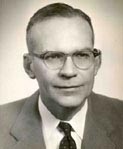President of Mary Washington from 1956 until his retirement in 1974, Grellet C. Simpson’s 18-year tenure was characterized by an unequivocal belief in the liberal arts tradition. For him, the liberal arts process was more important than any body of studies or the ends to which it led. Yet, even with his strong endorsement for an open, democratic exchange of ideas among students and faculty, he also gave some thought to what might follow graduation, establishing the Counseling Center and the Career Placement Bureau. With a major emphasis on academics, he oversaw the institution of intermediate and final honors for outstanding students, annual exhibitions of modern art, and the formation of chapters of Mortar Board and Phi Beta Kappa.
Dr. Simpson offered the faculty and students new opportunities for self-expression and engagement. Under his direction, attendance at professional meetings was encouraged, teaching loads were reduced from 15 to 12 hours a week, and an India Faculty Exchange Program was established. He encouraged the faculty to keep levels of instruction high, yet he relaxed several other aspects of the students’ college experience, including the elimination of Saturday classes. Bermuda shorts, slacks, and pedal pushers were first allowed to be worn on campus, but not to class. Later though, his administration abolished the dress code and permitted students to smoke in various campus locations, to drink in their dormitory rooms, to enter and leave their dorms at any time, and to have friends of the opposite sex visit during certain hours.
Yet the most significant changes were about more than clothes and visitation hours. During the unrest of the late 1960s, students began to demand greater personal and social freedoms, the right to voice political and moral beliefs, and the power to help shape their educational futures. The direction of the College changed as well, first with the move toward coeducation in 1970, and then Mary Washington’s separation from the University of Virginia, which took effect in 1972. The desegregation of the institution was another major development during this time, and the number of black students increased steadily during Dr. Simpson’s tenure.
The campus and curriculum were adjusted with the school’s changing identity. Dr. Simpson’s administration introduced new major programs in art history, studio art, religion, economics, physics, anthropology, geography, geology, dance, and pre-foreign service, as well as programs for summer study and study abroad. Additional changes were forecasted for Mary Washington, including a graduate program and an enlargement of the nonresidential population. At the same time, the campus grew by six buildings: Combs, Goolrick, Bushnell, Russell, Jefferson, and Marshall, as well as an addition to the library. Belmont, now known as the Gari Melchers Home and Studio, was placed under the institution’s jurisdiction, and the College was elected to membership in the Southern Universities Conference.
Born in Norfolk and educated in Virginia’s public schools, Dr. Simpson received his bachelor’s degree from Randolph-Macon College in 1930. He taught English at Randolph-Macon Academy in Bedford and at Randolph-Macon College in Ashland for several years before earning master’s and doctoral degrees from the University of Virginia. Aside from four war years spent as a field supervisor for the American Red Cross, he continued to teach English at Randolph-Macon, moving swiftly through the ranks from instructor to full professor, and then to dean of the students and dean of the faculty. Even after becoming president, he taught Chaucer until his administrative duties become too time-consuming. His concern for quality teaching was reflected in the 1972 creation of the Grellet C. Simpson Award for Excellence in Undergraduate Teaching, an award presented to a deserving faculty member annually at commencement. After his retirement, Dr. Simpson moved to one of Fredericksburg’s historic neighborhoods. He passed away on December 24, 1997.

